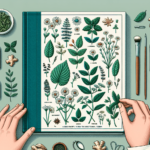So you’ve decided to explore the world of medicinal herbs, huh? Well, get ready to embark on a fascinating journey of botanical discovery. In this beginner’s guide to medicinal herb identification, we’ll uncover the secrets of various herbs and empower you with the knowledge needed to distinguish them. From understanding the importance of leaf shapes and sizes to unraveling the mysteries behind colors and textures, this article will equip you with the essential tools to identify and utilize medicinal herbs effectively. So grab your magnifying glass and let’s dive into the enchanting world of herbal identification!
Basic Understanding
Importance of Medicinal Herb Identification
Identifying medicinal herbs is essential for several reasons. First and foremost, it ensures that you are using the correct plant for its intended purpose. Different herbs have different properties and effects on the body, so misidentifying a plant could lead to ineffective or even harmful results. By correctly identifying medicinal herbs, you can ensure that you are using the right plant for the desired health benefits.
Furthermore, the identification of medicinal herbs allows for proper dosage and administration. Each herb has its unique dosage recommendations, and using the wrong plant could lead to incorrect dosing, which may affect the effectiveness of the treatment. Additionally, by properly identifying medicinal herbs, you can avoid potential interactions and contradictions with other medications or health conditions.
Common Uses of Medicinal Herbs
Medicinal herbs have been used for centuries to promote health and well-being. They can be utilized for various purposes, ranging from treating common ailments to supporting overall wellness. Common uses of medicinal herbs include:
-
Easing Digestive Issues: Many herbs, such as peppermint and ginger, have been traditionally used to alleviate digestive discomfort, including nausea, indigestion, and bloating.
-
Boosting Immune System: Certain herbs, like echinacea, have immune-boosting properties and are commonly used to prevent and treat respiratory infections, colds, and flu symptoms.
-
Calming Anxiety and Promoting Sleep: Herbs such as chamomile and lemon balm are known for their calming properties and are often used to reduce anxiety, promote relaxation, and improve sleep quality.
-
Alleviating Pain and Inflammation: Medicinal herbs like turmeric and willow bark have anti-inflammatory properties and can be beneficial for managing pain and reducing inflammation.
-
Enhancing Cognitive Function: Some herbs, such as ginkgo biloba, are believed to improve memory and cognitive function, making them popular among individuals looking to enhance their mental abilities.
Benefits of Identifying Medicinal Herbs
Identifying medicinal herbs provides numerous benefits that are worth considering. By being able to correctly identify these plants, you gain:
-
Safety and Efficacy: Identifying medicinal herbs ensures that you are using the appropriate plant to obtain the desired health benefits without any potential risks or adverse effects.
-
Cost Savings: By correctly identifying medicinal herbs, you can gather or purchase the specific plants you need, rather than relying on expensive commercial products or supplements. This can lead to significant cost savings in the long run.
-
Self-Sufficiency: Knowing how to identify medicinal herbs empowers you to rely on your own knowledge and resources for natural remedies. Instead of depending solely on modern pharmaceutical options, you can harness the power of nature to support your health.
-
Connection with Nature: The process of identifying medicinal herbs allows you to deepen your connection with nature. It encourages you to explore natural environments, observe plant characteristics, and learn about the interconnections between plants and humans.
Getting Started
Research and Study
Embarking on the journey of medicinal herb identification begins with research and study. Start by familiarizing yourself with the basics of botany and plant identification. Understand the key characteristics and terminology used when describing plants. This knowledge will provide a solid foundation for further learning.
Devote time to studying medicinal herbs specifically. Explore their traditional uses, active compounds, and potential side effects. Learn about the regions where these herbs grow, as this knowledge will be valuable when identifying them in the wild.
Consulting Experts
Seeking guidance from experts in the field can significantly accelerate your learning process. Connect with botanists, herbalists, or experienced individuals who have extensive knowledge of medicinal herbs. They can provide valuable insights, recommend helpful resources, and offer hands-on guidance for plant identification.
Joining herbalist communities or attending workshops and seminars can also provide opportunities to network and learn from experienced practitioners. Learning from those who have dedicated years to studying and working with medicinal herbs can greatly enhance your understanding and skillset.
Building a Reference Collection
Building a reference collection of medicinal herb resources is essential for accurate identification. Start by acquiring reputable books on herbal identification that include detailed descriptions, photographs, and illustrations. Field guides specific to your region can be particularly helpful, as they focus on plants found in your local ecosystem.
Supplement your collection with scientific journals, online resources, and reputable websites dedicated to medicinal herbs. These sources can provide up-to-date information and expand your understanding of plant identification.
Digital photographs, both your own and those found in reputable sources, can also serve as a valuable reference for comparing and identifying plants in the wild.
Tools for Identification
Field Guides
Field guides are indispensable tools for identifying medicinal herbs in their natural habitat. These pocket-sized books contain detailed descriptions, color photographs, and illustrations of various plants, making it easier to cross-reference and confirm your findings.
When selecting a field guide, ensure that it covers the herbs you are most interested in and includes accurate information for your specific region. Look for guides that include information on plant identification features, habitat descriptions, and notes on potential look-alike plants to avoid mistakes.
Online Resources
In the digital age, online resources can play a vital role in medicinal herb identification. Numerous websites and databases provide comprehensive information on various herbs, including their botanical characteristics, traditional uses, and potential side effects.
Use online resources to supplement your field guides and expand your knowledge. However, exercise caution and verify the credibility of the sources you use. Stick to reputable websites, educational institutions, and established herbal organizations.
Mobile Apps
With the increasing sophistication of technology, mobile apps have become convenient tools for plant identification. Many apps allow you to take photos of plants and compare them against existing databases to obtain accurate identifications. These apps often provide additional information about the plants, making them valuable resources for both beginners and experienced herbal enthusiasts.
Before relying solely on mobile apps, remember that they are not foolproof and should be used as a complementary tool rather than a standalone method. It’s always best to cross-reference your findings with other resources to ensure accuracy.
Key Identification Factors
Plant Characteristics
Understanding the key characteristics of medicinal herbs is crucial for accurate identification. Familiarize yourself with the various aspects of a plant, such as its growth habit, stem structure, leaf arrangement, and root type. Observing these features will help you narrow down the possibilities and identify the plant correctly.
Pay attention to the overall size, shape, and appearance of the plant. Note any distinct features, such as thorns, hairs, or specific color patterns. These characteristics can be major clues in distinguishing between different species.
Leaves and Flowers
The leaves and flowers of medicinal herbs often provide crucial information for identification. Examine the shape, size, and arrangement of the leaves. Note the presence or absence of lobes, serrations, or other unique leaf characteristics. Look for patterns in leaf veins, as these can vary between species.
Similarly, pay close attention to the flowers of a plant. Observe the size, color, shape, and arrangement of the petals. Note any distinct fragrance or peculiarities in the flower structure. The flowers can hold significant clues that aid in accurate identification.
Aroma and Taste
The aroma and taste of medicinal herbs can provide valuable information when identifying them. Crush a small portion of the plant, such as a leaf or flower, and smell it. Note any distinct scents or fragrances. Some medicinal herbs have unmistakable aromas that can be strong indicators of their identity.
If it is safe to do so, taste a small sample of the herb. Pay attention to any unique flavors, bitterness, or pungency. While this method should be approached with caution and avoided for toxic plants, it can sometimes provide additional confirmation when used alongside other identification techniques.
Identification Methods
Visual Examination
Visual examination is the primary method for identifying medicinal herbs. By carefully observing the plant’s characteristics, leaves, flowers, and overall appearance, you can identify specific traits that match the descriptions in your reference materials.
When conducting a visual examination, ensure that you have sufficient lighting and take your time to thoroughly study the plant. Pay attention to both macroscopic features, visible to the naked eye, and microscopic details, such as the arrangement of hairs or the presence of glands.
Microscopic Analysis
Microscopic analysis can be a helpful tool in confirming the identification of medicinal herbs. This method involves using a microscope to examine minute structures, such as pollen grains, stomata, or trichomes. These structures are often unique to specific plant species and can provide definitive confirmation of a plant’s identity.
While not all individuals may have access to a microscope, some botanical gardens, educational institutions, or herbalist groups may offer opportunities to utilize this technique. However, keep in mind that microscopic analysis is not always necessary for basic identification and may require specialized knowledge or training.
Chemical Tests
Advanced identification methods may involve chemical testing. By analyzing the chemical composition of a plant, specific compounds can be identified, leading to a conclusive identification. However, this method requires specialized knowledge, equipment, and caution, as some plants can be toxic or harmful.
Chemical tests are usually reserved for experts or professionals working in the field of herbal medicine, as they require access to a well-equipped laboratory and a thorough understanding of plant chemistry.
Common Medicinal Herbs
Chamomile
Chamomile is a well-known medicinal herb that is widely used for its calming properties. It is often consumed as a tea and is known to promote relaxation, reduce anxiety, relieve insomnia, and soothe digestive discomfort. Chamomile can be identified by its feathery leaves, small white daisy-like flowers, and apple-like fragrance.
Echinacea
Echinacea is a popular herb renowned for its immune-boosting properties. It is commonly used to prevent and treat respiratory infections, such as the common cold or flu. Echinacea can be identified by its distinctive purple petals, cone-shaped center, and rough-textured leaves.
Peppermint
Peppermint is a refreshing herb widely recognized for its ability to relieve digestive issues. It is often used to alleviate symptoms like bloating, indigestion, and nausea. Peppermint can be easily identified by its square stems, smooth oval leaves with serrated edges, and a strong, minty aroma.
Lemon Balm
Lemon balm is known for its calming effects and is frequently used to reduce anxiety and improve sleep quality. It has a gentle lemony scent and is often consumed as a tea or applied topically as an essential oil. Lemon balm can be identified by its heart-shaped leaves, pale yellow flowers, and distinct lemon fragrance.
Ginger
Ginger is a versatile herb used in various forms, including fresh, dried, or powdered. It is commonly used to alleviate digestive issues, reduce inflammation, and boost circulation. Ginger can be recognized by its thick, knobby rhizome, long green stems with lance-shaped leaves, and a spicy, pungent aroma.
Identifying Medicinal Herbs in the Wild
Plant Habitats
Understanding the natural habitats of medicinal herbs is crucial for locating and identifying them in the wild. Many herbs have specific habitat preferences, such as moist soil, shade, or specific elevations. Researching the preferred habitats of the herbs you are interested in will increase your chances of finding them successfully.
For example, chamomile thrives in sunny locations with well-drained soil, while lemon balm prefers partial shade and moist soil. By familiarizing yourself with the preferred habitats of medicinal herbs, you can narrow down your search and increase your chances of finding them in the wild.
Seasonal Variations
Seasonal variations play a crucial role in identifying medicinal herbs. The appearance of plants can change throughout the year, and certain identifying features may only be visible during specific seasons. Understanding these variations and knowing what to look for during different times of the year will help you accurately identify the herbs you encounter.
Pay attention to the flowering patterns, leaf color changes, and growth cycles of medicinal herbs. For example, peppermint blooms in the summer, with vibrant purple flowers appearing above its green leaves.
Safety Considerations
When identifying medicinal herbs in the wild, safety should always be a top priority. Not all plants are safe for consumption or external use, and some can be toxic or harmful. It is crucial to exercise caution and rely on accurate identification before using any herb for medicinal purposes.
Refer to reliable resources and consult experts to ensure that you are correctly identifying the herbs you encounter. Avoid harvesting or consuming any plant unless you are absolutely certain of its identity and safety.
Common Mistakes to Avoid
Confusing Similar-Looking Plants
One common mistake when identifying medicinal herbs is confusing them with similar-looking plants. Some plants may have similar leaf structures, flower colors, or growth habits, leading to potential misidentification. To avoid this, carefully examine all distinguishing characteristics and cross-reference with reliable resources to confirm the identity of a plant.
Relying Solely on Online Resources
While online resources are valuable tools, it is important not to rely solely on them for identification. The information available online may not always be accurate, and there is a risk of encountering incorrect or mislabeled plants. Therefore, it is essential to supplement online resources with field guides, expert advice, and personal study to develop a well-rounded understanding of medicinal herb identification.
Failing to Double-Check Information
Verification is essential when identifying medicinal herbs. It is crucial to confirm your findings through multiple reliable sources. Cross-reference your observations, use different field guides, consult experts, and compare plant samples to ensure the accuracy of your identification.
By failing to double-check information, you risk misidentifying a plant and potentially using it for the wrong purposes. Double-checking minimizes the chance of errors and ensures your safety when working with medicinal herbs.
Ethical Harvesting Practices
Sustainable Harvesting Methods
When gathering medicinal herbs, it is imperative to follow sustainable harvesting practices to protect the environment and ensure the long-term availability of these valuable plants. Some key principles of sustainable harvesting include:
-
Harvesting in moderation: Only collect what you need and avoid excessive harvesting that may deplete wild populations.
-
Selective harvesting: Choose mature plants while leaving young or unhealthy ones to allow for natural reproduction and growth.
-
Respect for plant communities: Be mindful of the interconnectedness of plant communities and avoid disrupting delicate ecosystems.
Respecting Growth Cycles
Respecting the growth cycles of medicinal herbs is crucial to ensure their continued availability and vitality. Each herb has its specific growth and reproductive patterns. By respecting these cycles, you allow the plants to rest, reproduce, and regenerate, ensuring their sustainability for future generations.
Harvesting during the appropriate times, such as after plants have flowered or when seeds have matured, prevents interfering with their natural growth and propagation. By giving herbs time to complete their life cycles, you contribute to the long-term preservation of their populations.
Protecting Endangered Species
Some medicinal herbs are endangered or at risk due to overharvesting or habitat destruction. It is essential to be aware of these endangered species and take extra precautions to protect them. Avoid harvesting endangered plants in the wild and support organizations working to conserve and restore their habitats.
If you encounter endangered species during your explorations, report the sighting to local authorities or conservation groups. Your involvement can contribute to the preservation of these critical plant populations.
Conclusion
Continued Learning and Experience
Identifying medicinal herbs is a journey that requires continuous learning and hands-on experience. Embrace opportunities to deepen your knowledge by studying botany, connecting with experts, and exploring the natural world. As you gain experience and become more familiar with medicinal herbs, your identification skills will improve, allowing you to confidently recognize and harness the benefits of these incredible plants.
Benefits of Medicinal Herb Identification
The benefits of identifying medicinal herbs extend far beyond personal health and well-being. By developing the skill of identification, you contribute to the preservation of traditional knowledge, the conservation of plant diversity, and the promotion of sustainable practices. Additionally, the self-sufficiency gained through medicinal herb identification empowers you to take control of your health and connect with the natural world around you. So, embark on this exciting journey of medicinal herb identification and unlock the incredible benefits it brings.





